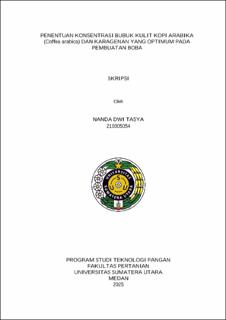| dc.description.abstract | This research was conducted to determine the effect of arabica coffee husk powder concentration and carrageenan concentration, as well as their interaction, to produce boba of the best quality. The study used Response Surface Methodology (RSM) randomized with Central Composite Design (CCD) with 2 factors: arabica coffee husk powder concentration (2%; 3%; 4%) and carrageenan concentration (0.7%; 0.8%; 0.9%). The responses tested were moisture content, water absorption, color index (L*, a*, b*, oHue), antioxidant activity, texture profile (hardness, cohesiveness, adhesiveness, gumminess, and chewiness), hedonic value of color, taste, aroma, general acceptability, and hedonic value of chewy texture. The results showed that the concentration of arabica coffee husk powder significantly affected (P<0.05) moisture content, water absorption, color index (L*, a*, b*, oHue), antioxidant activity, hedonic value of color, hedonic value of taste, and general acceptability. The concentration of carrageenan significantly affected (P<0.05) moisture content, water absorption, antioxidant activity, texture profile (hardness, cohesiveness, adhesiveness, gumminess, and chewiness), general acceptability, and hedonic value of chewy texture. The interaction between the concentration of arabica coffee powder and the concentration of carrageenan has a significant effect (P<0.05) on water absorption. The optimization obtained using RSM-CCD resulted in arabica coffee husk powder concentration of 3.992% and carrageenan concentration of 0.900% with a desirability value of 0.818. The optimized sample was then tested, resulting in an ash content of 0,1313%, potassium level of 81,4450 mg/100 g, dietary fiber of 4,2850%, fat content of 0,0677%, protein level of 6,7064%, carbohydrate content of 26,8776%, a total of 134,9453 kcal, and total sugar of 2,5428%. | en_US |


